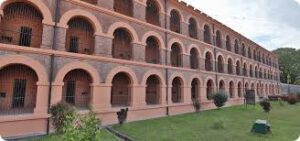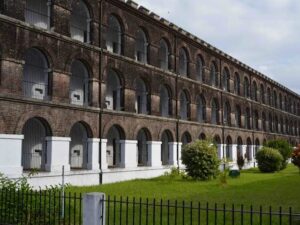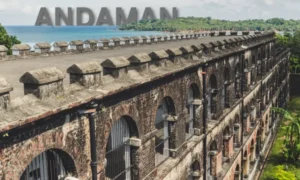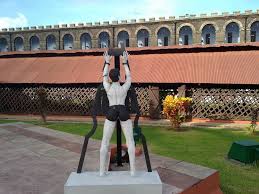Introduction: A Glimpse into the Horrors
Have you ever wondered what horrors lay behind the walls of one of India’s most infamous prisons?
The Cellular Jail, often referred to as Kālā Pānī or “Black Water,” is more than just a piece of history; it stands as a chilling reminder of the sacrifices made in India’s struggle for independence.
Built between 1896 and 1906, this colonial prison aimed to keep political prisoners and criminals isolated from one another. The British set it up in the Andaman Islands to clamp down on rebellion after the First War of Independence in 1857.
Its unique starfish shape, with seven wings branching out from a central watchtower, was designed for close surveillance and to prevent inmates from forming relationships or sharing their stories.
Each of the 698 cells was small and suffocating, measuring just 13.5 feet by 7 feet, with minimal ventilation, making life inside unbearable.
The jail became synonymous with suffering and sacrifice, earning its grim nickname due to the deaths that occurred within its confines
Exploring Cellular Jail: The Dark Legacy of India’s Freedom Struggle Through This Blog

Join us as we explore its corridors and listen to the stories of bravery and resilience, we will gain a deeper understanding of this significant chapter in India’s history through this blog. visit our latest blog also Srinivasa Ramanujan: The Self-Taught Mathematical Genius and 9 Historical Monuments That Define Nepal’s Heritage
The Dark History of Cellular Jail

The Cellular Jail, found in Port Blair on the Andaman Islands, is a touching symbol of India’s battle for freedom. Built between 1896 and 1906, it was created to detain political prisoners who stood against British rulers.
Its layout was inspired by the Panopticon concept, which let guards keep an eye on inmates without being visible, creating complete isolation. The design of the prison was intentional, as the British wanted to stop inmates from talking to each other.
The term “Kala Paani,” which translates to “Black Water,” highlights the harsh truth of the prison’s isolated setting, making escape almost out of the question. Many prominent freedom fighters, such as Veer Savarkar, were locked up in this jail, enduring some really harsh conditions.
The conditions were brutal, with things like solitary confinement, forced labor, and harsh punishments designed to break those who opposed colonial rule.
As the freedom struggle grew stronger, the jail earned a reputation for suffering and sacrifice, making it a key part of India’s historical narrative.
Architectural Wonder: Design and Structure

The structure of Cellular Jail is just as interesting as the stories behind it. It’s laid out in a starfish shape, featuring seven wings that fan out from a central watchtower.
Built with puce-colored bricks from Burma and local stones, each wing contained separate cells for solitary confinement.
They built the place with thick walls and barred doors, giving it double the security and really emphasizing the isolation for the inmates. The central tower had a big bell that served as an alarm during emergencies.
The whole design was carefully crafted to keep prisoners from communicating, which not only isolated them but also made it easier for a few guards to supervise a large number of inmates.
The three-story building used to have 698 cells, each only 13.5 by 7 feet in size. Without basic facilities like toilets, life was pretty tough for the inmates.
As time went on, the jail faced damage from natural disasters, including a big earthquake in 1941 that caused several wings to be torn down.
Nowadays, only three wings are still standing, serving as a stark reminder of its history.
This design served a practical purpose but also stood as a symbol of the oppressive British colonial rule, making Cellular Jail a haunting yet fascinating architectural marvel that tells a story of hardship and strength.
Life Behind Bars: Conditions and Treatment

Being locked up in a Cellular Jail was a nightmare for the inmates, filled with extreme pain and hardship. The prison was set up for total isolation, with each of the 698 cells holding just one person.
This solitary setup was meant to break the will of anyone who opposed British rule. Inmates were allowed out of their cells only once a day for a quick stretch, and even that was under harsh conditions.
The cells were tiny, around 13.5 by 7 feet, lacking toilets or proper sanitation. Inmates had to use a small earthen pot for their needs, which created filthy conditions that only worsened their physical and mental well-being.
The psychological pain of isolation was just as crushing. Many prisoners expressed feelings of despair and a lack of hope, as they were completely cut off from any communication or support.
The already oppressive environment was made worse by the brutality of the jail staff, who kept strict order through fear and violence.
Notable freedom fighters like Veer Savarkar and Barin Ghosh lived through these harsh conditions and wrote memoirs that reveal the incredible resilience of the human spirit in the face of such challenges.
Life in Cellular Jail wasn’t just about physical punishment; it was a deliberate effort to break the spirit of anyone who dared to stand up against colonial rule.
Notable freedom fighters like Veer Savarkar and Barin Ghosh lived through these harsh conditions and wrote memoirs that reveal the incredible resilience of the human spirit in the face of such challenges.
Cellular Jail is filled with incredible stories of bravery and resilience from the fight for India’s freedom.
One of the most well-known inmates was Veer Savarkar, a revolutionary who was a key figure In pushing for India’s independence from British rule. He spent nearly 50 years in prison, and his writings during that time inspired many others to join the freedom struggle.
Other significant figures like Bhai Parmanand and Barindra Kumar Ghosh were also instrumental in the revolutionary efforts against British colonialism.
Their sacrifices highlight how important this jail was to India’s independence movement. Many inmates took the chance to write letters and manifestos that later helped gather public support for their cause.
The legacy of these heroes still inspires future generations in their ongoing fight for justice and equality.
Cellular Jail Today: A National Memorial

Nowadays, the Cellular Jail is recognized as a National Memorial, dedicated to remembering the sacrifices of freedom fighters who faced severe hardships while imprisoned.
After India achieved independence in 1947, there was a strong urge from former prisoners and political leaders to maintain the jail as a symbol of the fight against British rule.
In 1979, the Indian government officially designated it as a national memorial, making sure that the stories of courage and perseverance would never fade away.
There are three original wings that are still preserved for visitors to explore, serving as strong reminders of India’s quest for freedom.
The site has been turned into a reflective space, allowing people to engage with the history of those who suffered within its walls.
One of the highlights is the Light and Sound Show that takes place every evening, telling the gripping stories of inmates and their fight against colonial rule through engaging storytelling and stunning visuals.
Conclusion
Cellular Jail is more than a historical landmark; it represents a deep sense of resilience and sacrifice in the battle against oppression. Its haunting history highlights the struggles of countless freedom fighters who worked relentlessly for India’s independence. Walking through its corridors today, we’re reminded to pay tribute to those who suffered quietly yet remained committed to their fight for justice and liberty. By celebrating their legacy, we help ensure their stories live on and that we continue to champion the values they fought for—freedom, dignity, and human rights for all.



